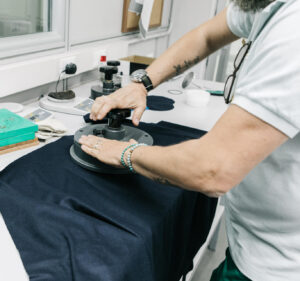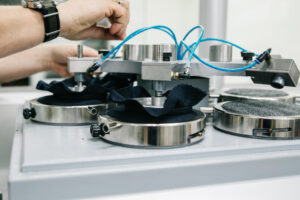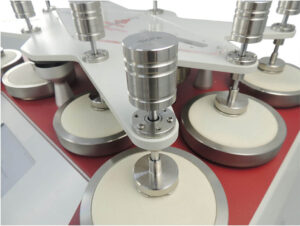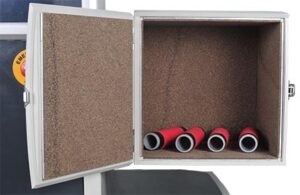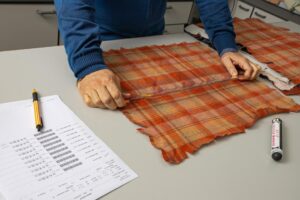How is a fabric's durability measured?
Discover the tests that fabrics undergo
In order to be defined as sustainable, a fabric must above all be durable.
What is durability? It is the ability of a material to exist for a long time without significant deterioration and, especially for fabrics, to resist wear through continual use and care. Durability has largely proven to be one of the most important aspect of fabrics’ quality and a key selling point for many brands and designers. How to measure it? Durability testing involves chemical and physical tests, among which measuring fabrics’ resistance to abrasion and pilling, tear resistance, strenght and elasticity, felting and shrinkage. Let’s see some of them.
How is natural wear simulated?
Natural wear can be simulated through different methods, nowadays it is mostly done by testing both the fabric’s pilling, abrasion, fuzzing and matting resistance . These tests provide important quality indexes of textile products and they can be done with special and specific machines: the Martindale and the Pilling Box.
What is pilling? The term “pilling” is referred to a surface defect occurring in textile fabrics and consisting of entangled fibers forming, the so called “pills”. They could be a bobble, fuzzball, or lint ball that appears on clothes whose quality has degraded due to many factors. The usage of clothes, the washing of clothes, their constant exposure to light, air, and weather are some of the few reasons why fabric pilling happens. When fibers loosen, they begin to push out treads to the surface, thereby breeding abrasion and causing fabric pilling. It is worthy to note that the balls (pills) seen on the surface of the fabric are fibers that haven’t broken but protrude through the stretching and loosening of the material (Read more on fabric’s pilling, the most feared garment’s enemy). Fabric pilling occurs on the part that receives the most abrasion, examples of these are garments’ collars, cuffs, thighs, and, in most cases, the rear parts of trousers. How does it occur and how is it tested?
Pilling resistance test with the Martindale
The Martindale Tester was developed by J.G. Martindale in the early 1940s under the auspices of the Wool Industries Research Association in England. Small samples of fabric are rubbed against each other with a specific pressure in a Lissajous figure in order to measure their ability to avoid or hinder the formation of small balls (pills) on their surface. The latters are formed during wear and washing, when fibres on the fabric surface “tease out” and become entangled. Under the influence of the rubbing action these loose fibres develop into small spherical bundles anchored to the fabric by a few unbroken fibres.
Pilling resistance test with the Pilling Box
Small samples of fabric are mounted on specific tubes (usually made with polyurethane) and are tumbled in cork-lined rotating wooden boxes. Accordingly, the samples move under the condition of no pressure and the specimens are conducted under mutual transient touching. As a consequence, unlike the Martindale method, the rubbing for samples is random. Even with this machine, what is measured is the fabric’s ability to avoid or hinder the formation of small balls (pills) on their surface. The latters are formed during wear and washing, when fibres on the fabric surface “tease out” and become entangled. Under the influence of the rubbing action these loose fibres develop into small spherical bundles anchored to the fabric by a few unbroken fibres.
How is pilling evaluated after the Martindale or the Pilling Box?
After 500, 1000 and 2000 cycles (sometimes even more) on the Martindale or a certain number of rolls in the Pilling Box, the textile specimens are compared against standard parameters. Using an overhead lighting, the appearance of the face of the specimens is compared to the pilling test standards using a scale from 1 to 5. Sometimes the values also falls between two rating standards. The higher the score, the more resistant the fabric’s surface will be. Ultimately, pilling is a complex property, affected by many factors, including type of fiber or blend, fiber dimensions, yarns and construction, finishing treatments. Plus, it may also be accompanied by other surface phenomena, such as loss of cover, color change, localized frosting, or fuzzing. See here below the illustrated rating scale to evaluate pilling results.
Abrasion resistance test with the Martindale
Abrasion is manifested in the morphological changes of the fabric, which are mainly damage, loss of quality, discoloration of appearance, and pilling. There are many methods for testing the wear resistance of textile products, such as flat grinding method, curved grinding method, hemming grinding method and compound grinding method. The Martindale method is a kind of flat grinding method, which is widely used in the abrasion resistance testing. Small samples of fabric are rubbed against known abrasive surfaces with a specific pressure in a Lissajous figure in order to measure the fabric's resistance when repeatedly rubbing with other materials. The test ends when threads break according to test method and the results are compared against standard parameters, the higher the score of rubs, the more suitable the fabric is for heavier usage. Key factors in fabric abrasion are the type of abradant, the direction and amount of force, the tension on the substrate, and whether the material is wet or dry.
Tear strenght test
The tearing strength is defined as the force required to start or to continue to tear a fabric, in either weft or warp direction, under specified conditions. It is an important indicator of the fabric's quality and it is tested with a special machinery, the Elmendorf pendulum. Basically, the pendulum is lifted up to a certain height and – when released – it tears the fabric, providing the required force to propagate a single-rip tear starting from a cut in fabric and enabling a rapid determination of the dynamic resistance.
Tensile strenght test
In the simplest terms, tensile strength is the ability of a material to withstand a pulling (tensile) force and typically refers to the strength and elongation properties of the material. This fabric's ability is one of the most widely measured properties in fashion and it is usually tested with a special machine: the Tensile Tester. A small sample of fabric is held in two places and extended until it breaks. The results of this test really depend on many factors, such as fibre type, fabric construction, weaving and finishing.
What happens during the felting and shrinkage test?
In order to determine dimensional stability properties, fabrics are washed in the wascator. ISO washing machine-Wascator is the standardized equipment for simulating home laundry test conditions: changes of fabrics or garments, colorfastness to detergents or bleach, appearance changes and retention of creases.
About Manteco, Italian premium textiles and circularity since 1943
After decades in the fashion world, in 2018, we have created the Manteco Academy project, through which we give webinars, in-person lessons and workshops on eco-design, circular economy and sustainability to numerous fashion schools, technical universities and brands worldwide. Thanks to this educative commitment and our heritage, we are often invited as guest speaker at events, panels, podcasts and conferences about sustainable fashion and circular economy.


